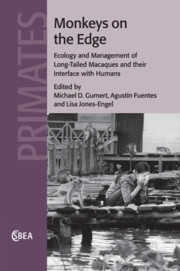Book contents
- Frontmatter
- Contents
- List of contributors
- Foreword
- Preface
- Acknowledgements
- Part I The status and distribution of long-tailed macaques
- 1 The common monkey of Southeast Asia: Long-tailed macaque populations, ethnophoresy, and their occurrence in human environments
- 2 Distribution and current status of long-tailed macaques (Macaca fascicularis aurea) in Myanmar
- 3 Distribution and present status of long-tailed macaques (Macaca fascicularis) in Laos and their ecological relationship with rhesus macaques (Macaca mulatta)
- Part II The human–macaque interface
- Part III Ethnophoresy of long-tailed macaques
- Part IV Comparisons with rhesus macaques
- Part V Understanding and managing the human–macaque interface
- Index
- References
3 - Distribution and present status of long-tailed macaques (Macaca fascicularis) in Laos and their ecological relationship with rhesus macaques (Macaca mulatta)
from Part I - The status and distribution of long-tailed macaques
Published online by Cambridge University Press: 16 May 2011
- Frontmatter
- Contents
- List of contributors
- Foreword
- Preface
- Acknowledgements
- Part I The status and distribution of long-tailed macaques
- 1 The common monkey of Southeast Asia: Long-tailed macaque populations, ethnophoresy, and their occurrence in human environments
- 2 Distribution and current status of long-tailed macaques (Macaca fascicularis aurea) in Myanmar
- 3 Distribution and present status of long-tailed macaques (Macaca fascicularis) in Laos and their ecological relationship with rhesus macaques (Macaca mulatta)
- Part II The human–macaque interface
- Part III Ethnophoresy of long-tailed macaques
- Part IV Comparisons with rhesus macaques
- Part V Understanding and managing the human–macaque interface
- Index
- References
Summary
Introduction
Lao Peoples' Democratic Republic (i.e., Laos), situated in the center of the Indochina Peninsula and encompassing 14–22.5°N, consists of diverse environments, including Xay Phou Louang (Annamite Cordirella) in the east, the Mekong River in the west, and plains in between. More than 15 percent of the national land area has been designated as National Protected Areas (NPAs) by the government of Laos since 1993. Compiling museum data and literature, Fooden (1980, 1995) sketched the distribution of long-tailed macaques in Laos. In addition, assessments were carried out in the 1990 on Laos's wildlife in these NPAs and these surveys also reported the distribution of macaques (Duckworth et al., 1999). These reports suggested that long-tailed macaques were distributed only in southern-most Laos, which is a region consisting of mountainous areas (i.e., Bolaven plateau, Xay Phou Louang) and tributaries of the Mekong River. However, the present distribution and current population status of long-tailed macaques are not known.
Primate fauna is rich in southern-most Laos, which includes prosimians (i.e., lorises), cercopithecids, colobines, and lesser apes (i.e., gibbons) (Duckworth et al., 1999). Laos contains highly endangered species, such as red-shanked douc langurs (Pygathrix nemaeus) and yellow-cheeked gibbons (Nomascus leucogenys gabriellae; Duckworth et al., 1999), as well as typically common monkeys such as the rhesus (Macaca mulatta) and long-tailed macaque (M. fascicularis). All non-human primates in Laos are currently under threat of extinction because their habitats have been lost to commercial logging, hydraulic power development, and agriculture, all of which have been driven by increases in human population, economical development dependent on natural resources, and foreign capital (Duckworth et al., 1999).
- Type
- Chapter
- Information
- Monkeys on the EdgeEcology and Management of Long-Tailed Macaques and their Interface with Humans, pp. 72 - 98Publisher: Cambridge University PressPrint publication year: 2011
References
- 4
- Cited by



